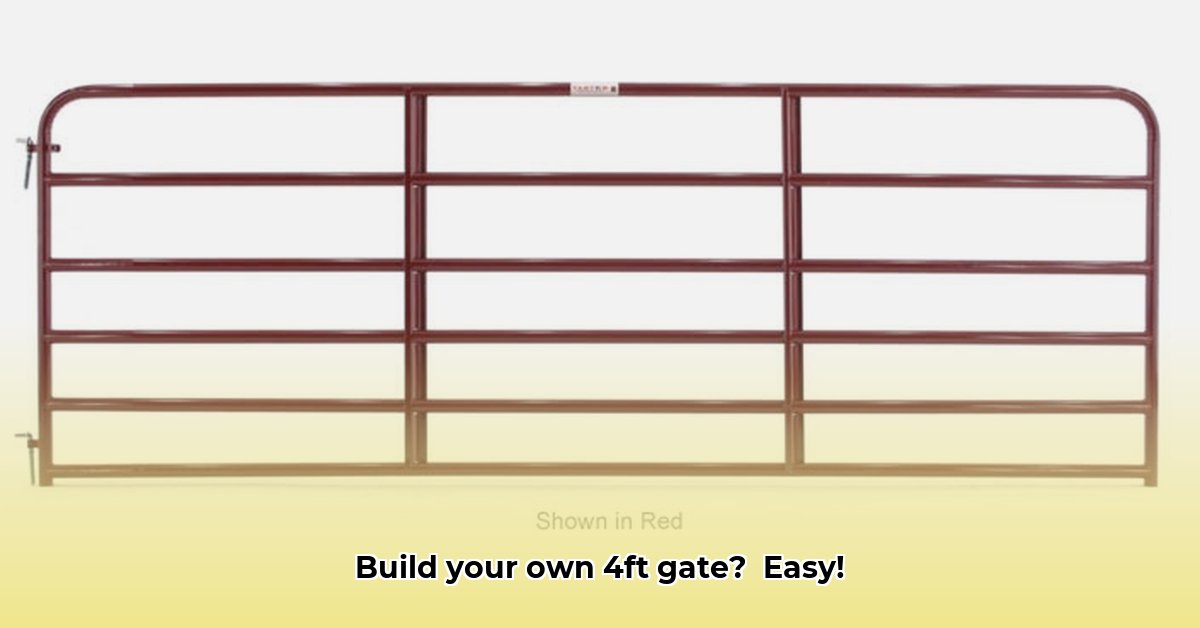
4ft Gate Tractor Supply: Enhancing Sustainable Farming Practices
Building durable and sustainable fencing is crucial for efficient and environmentally conscious farming. A simple 4-foot gate from Tractor Supply can be a surprisingly effective component in a broader strategy of sustainable land management. This guide details its installation, maintenance and how it contributes to a more holistic approach to farming. It also explores broader sustainable fencing options. For more Tractor Supply locations, check out this helpful resource.
Choosing the Right Gate: Prioritizing Sustainability
Selecting the right gate material is the foundation of a sustainable fencing strategy. Consider factors such as the gate's longevity, material sourcing (locally sourced reduces transportation emissions), and whether recycled materials were used in its construction. A durable gate minimizes waste and reduces the need for frequent replacements. This mirrors the long-term investment perspective of planting a tree – upfront effort leads to lasting benefits. Choosing a gate made from (partially) recycled materials directly reduces the demand for new resources.
Installing Your 4ft Gate: A Practical, Step-by-Step Guide
Installing your Tractor Supply gate is a manageable DIY project. Follow these steps for optimal results:
Site Preparation: Clear the area, ensuring level ground. This crucial step prevents future instability.
Post Installation: Securely set fence posts in concrete for maximum stability. This significantly increases the gate’s lifespan and structural integrity.
Gate Hanging: Carefully attach the hinges to both the gate and the posts, ensuring proper alignment for smooth operation.
Latch Installation: Securely attach the latch mechanism and test its functionality. A reliable latch is crucial for animal containment and security.
Final Inspection: Thoroughly inspect the entire setup, ensuring the gate opens and closes smoothly and the structure is stable.
Maintaining Your Gate: Extending its Lifespan
Regular maintenance is key to extending the gate's longevity:
Regular Cleaning: Remove dirt and debris to prevent rust and corrosion, thus preserving the gate's structural integrity and appearance.
Lubrication: Lubricate hinges and latches regularly to ensure smooth operation.
Damage Inspection: Regularly inspect for damage and address any issues promptly. Preventative maintenance is far more cost-effective than major repairs.
Sustainable Farming Applications of Your New Gate
While seemingly small, this gate plays a significant role within a broader sustainable farming strategy:
Rotational Grazing: Strategic fencing, including gates, enables rotational grazing, leading to healthier pastures and improved soil health. This practice increases pasture productivity and reduces the need for chemical fertilizers.
Water Management: Fencing can protect water sources from livestock, reducing soil erosion and water pollution.
Chemical Reduction: Sound pasture management, facilitated by proper fencing, often reduces the need for pesticides and fertilizers, minimizing environmental impact.
Wouldn't you agree that responsible land management directly benefits your bottom line and environmental health?
Weighing the Pros and Cons: Is a Tractor Supply Gate Right for You?
| Advantages | Potential Drawbacks |
|---|---|
| Readily available and cost-effective | May require some assembly |
| Relatively easy installation | Durability varies depending on materials |
| Suitable for various farming contexts | Limited customization options |
Choosing Sustainable Fencing Materials for Eco-Friendly Farming
Choosing sustainable fencing materials goes beyond the initial gate. Consider these options:
Recycled Plastics: Durable and long-lasting reducing landfill waste. The upfront cost is higher but the longevity translates to long-term savings.
Living Fences: Native plants create a natural, sustainable barrier promoting biodiversity. However, they require time to establish.
Bamboo: A rapidly renewable, strong, and versatile material.
Reclaimed Wood: A sustainable alternative provided it's properly treated to prevent decay.
Remember, selecting the best materials hinges on your specific needs and local conditions. Always check local codes and regulations.
Conclusion: Building a Sustainable Future, One Gate at a Time
Investing in sustainable fencing is a long-term commitment that benefits both your farm's productivity and the environment. This 4ft Tractor Supply gate, while a seemingly small component, contributes to a more holistic and sustainable approach to farming. By combining thoughtful planning and sustainable material choices, you can create a fence system that works in harmony with nature and your farming goals. This simple gate is a practical step towards efficient and eco-conscious farming.